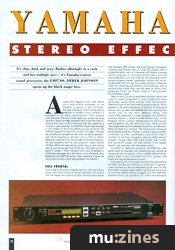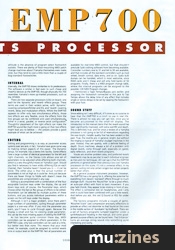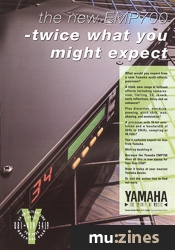Magazine Archive
Home -> Magazines -> Issues -> Articles in this issue -> View
Yamaha EMP700 | |
Stereo Effects ProcessorArticle from Sound On Sound, August 1992 | |
It's slim, dark and sexy, flashes alluringly in a rack and has multiple uses - it's Yamaha's latest sound processor, the EMP700. Derek Johnson opens up the black magic box.

Anyone who happens to be in the market for a multi-effects processor at the moment is going to get confused. This type of product, which has become so essential to modern music creation, is available in so many permutations from various manufacturers that you could easily just accept the shop assistant's advice and buy whatever they've got the most of. Among the many current machines that you might try is Yamaha's latest example, the EMP700. Placed fairly squarely in the middle of the multi-effects pricing structure, the EMP700 appears to have a lot to offer. On paper, Yamaha are providing the prospective user with true stereo operation, and 16-bit sampling at 44.1kHz, with a 20Hz to 20kHz frequency response. The 700 provides 90 preset programs, 50 user programs and 50 card programs, based around 29 basic effects. Its externals are pretty tasty as well, oozing class as soon as you get it out of the box. Although the front panel is simple, I think Yamaha must have embedded a subliminal message into the fascia, since everyone who passed by the EMP700 while I was reviewing it gave the input level controls a twirl and prodded the buttons.
FULL FRONTAL
That simple front panel is logically laid out, with the chunky stereo input level control at the left. Between this control and the display are a group of LEDs showing input signal and overload, MIDI activity, and which group of programs is being used (Preset, User or Card). The display itself is a bipartite affair, with a 2-character LED display showing which program is currently being used, and the now-ubiquitous LCD (two lines by 16 characters) which shows program names, parameter names and so on. Underneath the LCD are four yellow buttons: these are used for choosing parameters while editing, and in normal play mode they can be used to select four programs (from the Preset, User or Card groups) for immediate recall.
Next to the LCD are up and down buttons, which are used to select programs in play mode and enter parameter values while editing; note that program selections have to be confirmed by pressing Recall, which appears in the next small group of buttons. This group of buttons also includes one labelled Memory; pressing this returns you to the main Memory Mode, and continually pressing it cycles through the different memory banks — there are 90 Presets (plus Initial Program, which is a basic starting place for editing your own programs), 50 User and 50 on card. There are two main parameter buttons labelled Dyn(amic) and Rev(erb). More on these in a moment. The Store button obviously stores edited programs, Assign is used for assigning MIDI controllers to effect parameters, and Utility hides a number of facilities (program naming, MIDI setups, program change table, RAM card format, Bulk Dump, and footswitch assign). All that remains is the Bypass button, the card slot, and the power switch.
As befits its traditional structure, the EMP700's rear panel holds no surprises: two unbalanced jack sockets as inputs and two as outputs, with a +20dB/+4dB sensitivity switch, MIDI In and switchable Out/Thru sockets, and finally the tap tempo/bypass socket.
Considering the mid-range price and the applicability of what Yamaha are offering to musicians in general, I was surprised to see no dedicated guitar input on the front panel: a guitar really needs to go through some kind of pre-amp before being plugged into the EMP700. Another minus for guitarists of a less technological attitude is the absence of program select footswitch sockets. There are plenty of floor-mounting MIDI patch change machines about (Yamaha themselves even make one), but they tend to cost a little more than a couple of bog-standard footswitches.
INTERNAL
Internally, the EMP700 shows similarities to its predecessors. The software is similar in feel even to such cheap and cheerful devices as the EMP100, though physically the 700 resembles Yamaha's more up-market processors, such as the SPX900.
There are two separate processors (LSIs) on board, one each for the 'dynamic' and 'reverb' effects groups. These terms are used in their widest sense, with 'dynamic' covering compressor/limiter and EQ, and 'reverb' covering reverb, delay and modulation effects. Whilst the EMP700 appears to offer only two simultaneous effects, those two effects are very flexible, since the effects from the two groups can be combined and used simultaneously, either in a serial, parallel, or reverse serial configuration. Thoughtful placement of the right effects can make the EMP700 sound like much more is going on than two effects might lead you to believe — the presets provide a good example of what can be achieved.
EDITING
Editing and programming is as easy as parameter access systems ever are and, in fact, Yamaha have gone some way to making certain aspects of this easier. The Dynamic group, for example, has a stereo link facility. Some effects have a large number of identical parameters for the left and right channels, so the Stereo Link allows one set of parameters to be adjusted while affecting both channels, which is a very thoughtful move on Yamaha's part. Should you find it necessary to have wildly differing EQs on each channel, then Yamaha haven't boxed you in — it can be done. The other plus is that the actual number of parameters is not as high as it could be. And just because there are fewer things to fiddle with doesn't mean the possibilities are compromised in any way.
Editing is accomplished with a combination of the four assignable function keys under the display, the up and down keys and, of course, the Parameter keys, which choose either the Dyn or Rev group of effects to be edited. Parameters can be selected by multiple pushes of these buttons, and you access individual parameters within a screen via the soft keys under the display.
Although it isn't a major problem, since there aren't huge numbers of parameters, cycling through parameter pages is a one-way affair. If you miss the parameter you want, you'll have to cycle through again. Because the display is small and has no viewing angle parameter, this can be the most irritating aspect of editing the EMP700.
As has become quite common these day, MIDI controllers can be assigned to effects parameters. In the EMP700's case, only two controllers can be used at a time, but better two than none. This means that your mod wheel, for example, could be assigned to control reverb time or output level on the EMP700. Not all parameters are available for real-time MIDI control, but that shouldn't preclude SysEx editing software from becoming available. Controller numbers one to 31 and 64 to 95 are available, and that includes all the standard controllers such as mod wheel, breath control, data entry, and so on. SysEx bulk dumps can be handled, which is most welcome, since RAM cards aren't cheap and will only hold banks of 50 programs. Finally, there is a MIDI program change table, where the internal programs can be assigned to the possible 128 MIDI Program changes.
I mentioned a Tape Tempo/Bypass jack earlier, and assigning the footswitch connected to this jack to Tap Tempo allows the delay time of any effect that includes single or stereo delays to be set by tapping the footswitch with your foot.
SOUND STUFF
Since editing isn't very difficult, it'll come as no surprise to hear that the EMP700 is a cinch to use in real life. There is almost no way you can get lost, once you've become accustomed to the small-ish display. The introduction to the manual claims that the reverb sound has been significantly improved, with extra warmth and depth. This is definitely true, and for once a review of a Yamaha processor is not going to be full of reservations regarding the over-bright, metallic quality that has been evident in the past. True, the reverbs are, in general, bright, but without the ringing so typical of Yamaha's budget machines in the past. Instead, they are sparkly, with a definite feeling of depth. Drum machines, always a bit of a problem with digital reverb, come through well, especially on gated, early reflection, and short reverb programs.
Vocals are another problem area, and preferred reverb treatments may be as peculiar to each individual engineer as mics and mic techniques. All I can say is that the EMP700 performs in general better than previous low-cost Yamaha processors on this score; it's not a universal effect, in my opinion, suiting not only certain singers but certain projects better than others.
As a general purpose instrument processor, however, the EMP700 has a lot going for it, offering the potential for everything from decent 'standard' effects through to much stranger stuff. I found the 'Round Pan' to be a great effect, an auto-pan effect with front to back movement. If you play held chords, they appear to be rotating in front of you. The effect is somewhat lost on headphones, and I only wish it could have been combined with just a little reverb. And before you ask, this not Q-Sound or RSS for under £500.
The factory programs include a couple of gems. 'Ricochet Snare' uses compression and early reflections to provide an effect not dissimilar to that found on the snare in the middle section of 'Autobahn' by Kraftwerk. There are a set of factory programs lumped together under a synth/keyboard heading in the manual, and some good-general purpose effects can be found here: 'Pad Enhancer' turns an average string sound into something quite interesting and swirly.
One oddball amongst the keyboard effects is 'Strong Wind'. To quote the manual: "using a suitable voice, the sound of strong wind can be simulated". It's actually quite useful, being a sort of flange/wah/reverb effect. The wah effects come in handy on a percussive preset (called, strangely enough, 'Wah Percussion'), and add a violent wah effect to a basic gated reverb effect. Very dramatic.
Amongst the vocal/chorus programs, 'Warm Vocal Rev' came off rather well, being pretty much what the name would imply. The plate simulations sound convincing, but this isn't surprising given that the reverbs are quite sparkly to begin with.
Guitar effects are pretty well part of the furniture now, as regards multi-effects processors, and the EMP700 is no exception. It's been kitted out with one specific effect, in the Dynamic group, called 'Compression-Distortion-EQ'. This has a simple noise gate built into the distortion section, which keeps all the amplified and compressed noise at bay in between playing. There are also effects dubbed 'Overdrive' and 'Stereo Wah', which will be of interest to the guitarist, though they're pretty good on synth patches as well. Also of note are some more off-the-wall programs: the 'Triple Pitch Shift' is used to produce wild spiral effects, where the sound arpeggiates onwards and upwards; 'Boom Boom' makes any vaguely explosive noise sound like a truly massive explosion, and 'Multi Flam' uses various delay times to make mock sequencer phrases (it needs editing to suit your tempo and style of music, but it's fun).
The ability to have four programs assigned to the soft keys under the LCD is rather handy: it means that any four programs can be instantly available without recourse to scrolling through the potential 190 programs on board the EMP700. These four programs are shown by number (P11, U30, C45 and so on) only.
CONCLUSION
We're getting close to the bottom line here and, to be honest, this is where it gets tricky. The list price of £449 is rather too high for those in the market for a Sub-£300 processor. That's a shame, since the EMP700 is as slick as its looks lead you to expect. I don't think the unit would be out of place in a demanding professional environment, but there is a lot of competition amongst processors at this price point. All I can say is have a listen: if you like Yamaha processing — and the EMP700 has a lot in common with Yamaha's catalogue past and present — you will love this machine. If you haven't had much contact with Yamaha effects, then this is a great place to start, and you may well be as impressed as I was. The EMP700 undoubtedly sounds good, and producing custom programs is easily accomplished.
My final reservations, especially in view of the cost, concern the lack of facilities for the guitarist and a limited user bank with only 50 programs. Perhaps there is also a slight lack of true multi-effects facilities — Yamaha's own FX500, while optimised for guitarists, and not having quite the sophisticated sound of the EMP700, offers six effects at once, and weighs in at less than £400. The SPX900, while costing over £600, offers eight effects simultaneously. But whatever the EMP700 may be perceived as lacking, the accessibility of the unit and, of course, the sound, go a very long way to making up for it.
Further information
Yamaha EMP700 £449 inc VAT.
Yamaha-Kemble Music UK, (Contact Details).
YAMAHA EMP700 EFFECTS IN FULL
| DYNAMIC | |
| CEQ: | Compressor-Graphic Equaliser |
| COMP: | Stereo Compressor/Limiter |
| PEQ: | Stereo Parametric Equaliser |
| ENH: | Stereo Enhancer |
| WAH: | Stereo Wah |
| PHS: | Phaser |
| OVD: | Overdrive |
| CDE: | Compressor-Distortion-EQ |
REVERB | |
| CHO: | Chorus |
| FLA: | Flanger |
| SYM: | Symphonic |
| PAN: | Round Pan |
| HMD: | Hyper Modulation Delay |
| TPI: | Triple Pitch Change |
| SPI: | Stereo Pitch Change |
| REV: | Reverb |
| GRV: | Gate Reverb |
| ER: | Early Reflection |
| ADL: | After Delay |
| MDL: | Mono Delay |
| SMD: | Stereo Modulation Delay |
| MTD: | Multi-tap Delay |
| R+D: | Reverb+Delay |
| P+R: | Stereo Pitch Change + Reverb |
| P>R: | Stereo Pitch Change > Reverb |
| S+R: | Symphonic + Reverb |
| F>R: | Flange > Reverb |
| D>E: | Delay > Early Reflection |
| D+C: | Delay + Chorus |
Publisher: Sound On Sound - SOS Publications Ltd.
The contents of this magazine are re-published here with the kind permission of SOS Publications Ltd.
The current copyright owner/s of this content may differ from the originally published copyright notice.
More details on copyright ownership...
Review by Derek Johnson
Previous article in this issue:
Next article in this issue:
Help Support The Things You Love
mu:zines is the result of thousands of hours of effort, and will require many thousands more going forward to reach our goals of getting all this content online.
If you value this resource, you can support this project - it really helps!
Donations for April 2024
Issues donated this month: 0
New issues that have been donated or scanned for us this month.
Funds donated this month: £7.00
All donations and support are gratefully appreciated - thank you.
Magazines Needed - Can You Help?
Do you have any of these magazine issues?
If so, and you can donate, lend or scan them to help complete our archive, please get in touch via the Contribute page - thanks!







